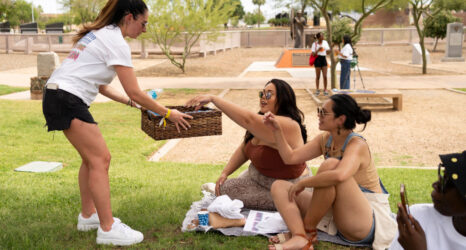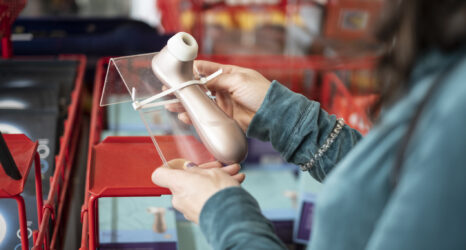I have a love-hate relationship with Pure Barre. As a cisgender, straight, white feminist in her thirties, I find fault in the franchise’s ideology and the culture it promotes—and strength in the way my body responds to the exercise.
Before there was Pure Barre, and its variations, there was Lotte Berk and her signature method—which “combined ballet, yoga and rehabilitative exercises to heal and hold onto her dancer’s figure”—in 1959’s London. Berk touted her method as helping women “get more pleasure from sex.” (An improved sex life is no longer an acknowledged benefit of barre, though sexualized pelvic thrusts are routine.)
One of Berk’s students, American Lydia Bach, opened a “Lotte Berk Method” studio in New York City in 1971. Dozens of off-brands popped up, forcing Bach into retirement in 2005. One of Bach’s former students may have been Pure Barre creator, Carrie Rezabek Dorr, who taught her first class in 2001 and began franchising in 2009. There are now more than 460 Pure Barre studios in the U.S. and Canada.
Dorr’s Pure Barre aims to “lift, tone and burn (or LTB),” which is also one of the brand’s signature phrases, describing both the exercise and its physical results. The ever-changing, 45-minute, full-body workout uses isometric movements. An isometric movement is tiny; as instructors like to say, “you feel it, I don’t see it.” In essence, muscle contraction is the exercise.
The most important part of Pure Barre is the “tuck.” Joanna Novak writes that “tucking might be the brand’s most pervasive move–and the most body-shaming.” While Novak is right—the tuck is tortuous in its resemblance of the stomach being sucker-punched or tied into a bodice—she fails to mention that other exercises also rely on it, albeit by another name. In yoga, students are reminded to suck in their stomachs (uddiyana bandha). Tucking is also “contracting,” a phrase used in the Jazzercise craze of the 60s and 70s.
At the barre, the tuck is highly-policed, reinforcing a gendered and unequal form of exercise for women, especially for women do not meet conventional ideals of beauty. There’s a lot of pressure to conform to certain ideals, ideals premised on whiteness—designer athleisure wear and long, highlighted ponytails.
It’s an all-too-common-shame that many women stop exercising out of fear of being prejudiced against by other women. Pure Barre certainly pits women against each other. The climate of the studio is like high school; the silent prejudice of women judging each other for not appearing feminine enough is palpable. It’s possible that many women stop going to Pure Barre because they can’t withstand being policed while trying to burn calories. Women experience these appearance-related prejudices on the daily, for free; paying 40 dollars a class to feel the ever-present pangs of appearance-related prejudices is unnecessary. It’s also heinous.
While accessories are often used, the most essential is the “mind-body connection.” In theory, the mind-body connection keeps us focused on ourselves to avoid self-comparison or judging others—which is difficult with floor to ceiling to mirrors. Instructors ask us to close our eyes as we struggle through shaking legs and fatigued muscles. But just when you feel like you’re safe, like you’re working out alone, the instructor calls you out by name: “nice form, Becky!” “Lift your heels, Natasha!”
All heads inevitably turn.
Instructors’ language use is perhaps the brand’s most egregious error. Instructors learn and use students’ names during class; there is no anonymity in Pure Barre. Framed as a form of praise and encouragement, teachers single clients out as yet another way to police and body shame during what is an extremely vulnerable activity.
Yet, even with all its faults, I do Pure Barre at least three days a week—but I do it in the privacy of my own home. In leggings and sticky socks, I exercise along to streamed videos of instructors leading students in studios through isometric movements. Before Pure Barre, I feared lifting weights, almost as much as I feared getting “bat-wings.” Then, I started using hand weights in class. Now, I’ve even used ankle weights. (And my muscles haven’t gotten any bigger, they’ve just gotten firmer.)
Because of Pure Barre, I’ve gained confidence in my body—which is saying something, because, like many women, I suffer from eating disorders, body dysmorphia and general anxiety. I’ve tried Pilates, yoga, spinning, dancing, Zumba—but from Pure Barre, my bodily changes were more noticeable.
I’ll keep hoping for a more feminist form of exercise. But in the meantime, I’ll keep doing Pure Barre—however much I might be ashamed to admit it to others.





